RSS Post Importer - Use Case - Building the Template and How It Can Look Like
Use Case – Building the Template and How It Can Look Like.
Note: This guide requires:
- RSS Post Importer – This document uses version 1.5.9.
Video Use-Case
Introduction
The RSS Post Importer plugin lets you import posts or pages from an external site to your Wordpress site. It can be useful for linking together sites that you own that should share content mutually, or for scraping similar sites for content that relates to what your site is about.
It is a onetime set up plugin that continues to work after being configured allowing you to find great quality content providers and funnel them through your domain.
The RSS Post Importer is a must-have for affiliate marketing, for event listing sites, for new sites and for keeping content across multiple sites up to date without all the donkey work.
Use Case Front-End

Use Case Assumptions
In this example use case guide we will consider how to build a post template for fetched articles. If you want to get to know the whole process of creating a feed, you can learn it in our use case guide: RSS Post Importer - Use Case - How to Import Articles Using RSS Feed From Another Site
We assume that you have already bought the plugin, but not installed it yet.
It follows:
- Installing the plugin
- Quick Recap
- Shortcodes for the Template
- Custom XML Tag
- Building Post Template
- End Result
- Extra - No Image Is Shown - Troubleshooting
Installing the Plugin
The process is the same for all CM plugins and add-ons.

- Download the plugin from your customer dashboard.
- Log in to WordPress and navigate to the WordPress Admin → Plugins settings.
- Click on Add New.
- Activate it and add the license.
Learn more: Getting Started - Plugin Overview
Quick Recap
As in this example use case guide we cover only how to build template for fetched articles, we recommend you to get to know first how to work with the plugin in general. You can learn the following in our another use case guide:
- Configuring the plugin
- Creating a Feed
- Choosing What's Important in the Feed
- Choosing What's Important in the Post
- How the Posts Are Displayed (Post Template)
- Managing Feeds
- Fetch History
Learn more about it here: RSS Post Importer - Use Case - How to Import Articles Using RSS Feed From Another Site
Shortcodes for the Template
While creating an RSS feed you can see the list of customizable shortcodes that can be used for building a post template. To find them, navigate to Admin Dashboard → CM RSS Post Importer Pro → RSS Feeds. Then click the button Add RSS Feed.
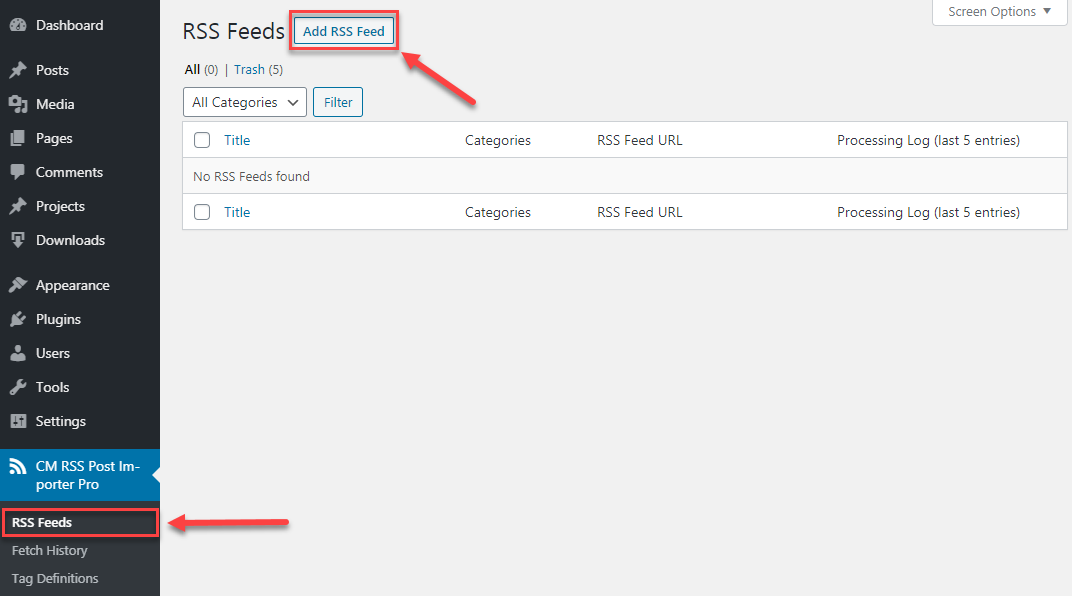
Scroll down to the section Processing Settings (Import). In this step, we'll define how the posts will be processed. This means, for instance, trimming the title, removing HTML tags and also pinpointing the source URL, so that we can include it later in the post.
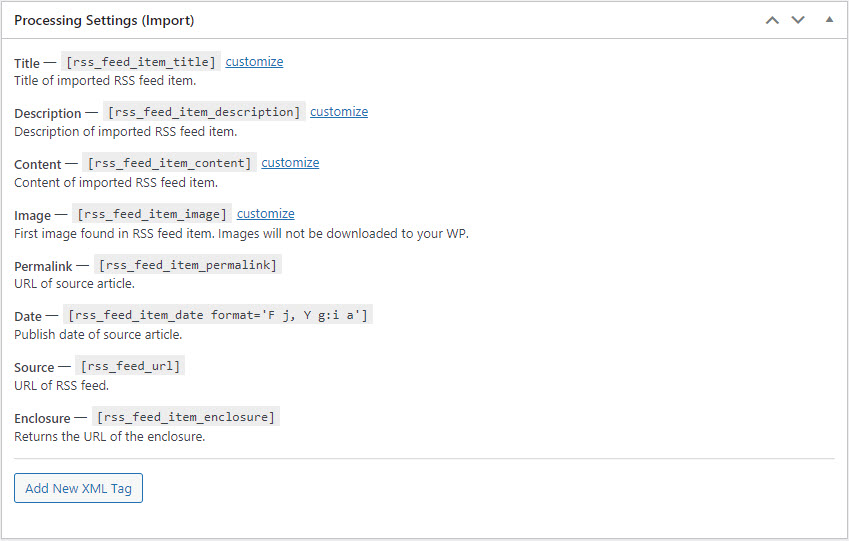
By clicking on customize next to some of the shortcodes it is possible to change the way posts are imported.
Title and Description
The Title and Description have the same configuration options.
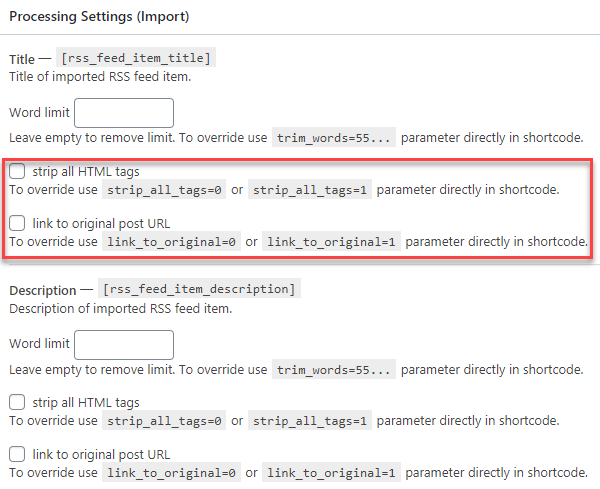
- Word Limit - Limits the number of words from the beginning of the text body that will be imported. You can also trim the number of words by using the parameter trim_words=x in a shortcode, being x the number of words. For example if you want display only the first 55 characters of the title you can use
[rss_feed_item_title trim_words=55]. This also applies to the Description or Content shortcodes. - Strip all HTML tags - Removes all HTML tags (such as <h1>, <h2> <strong> etc.), importing nothing but a plain text version of the original feed. You can use a parameter inside the shortcode. For example
[rss_feed_item_title strip_all_tags=1] - Link to original post URL - Force linking to the original content / post URL.
Content
The Content has the same configuration as Title and Description plus two additional options:
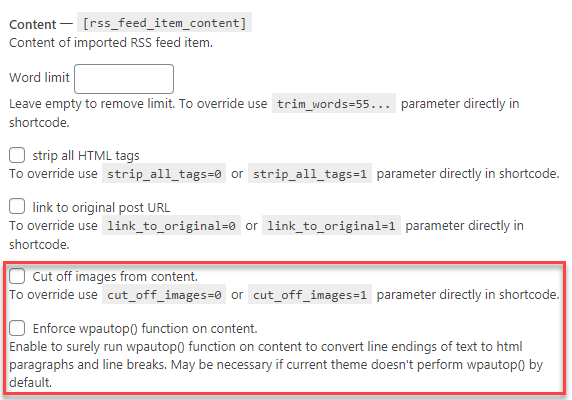
- Cut off images from content - Exclude images from feed item content.
- Enforce wpautop() function on content - Enable to surely run wpautop() function on content to convert line endings of text to html paragraphs and line breaks. May be necessary if current theme doesn't perform wpautop() by default.
Tip 1 - Making sure the plugin imports paragraphs and line breaks
When including the content of the post, consider using [rss_feed_item_content] instead of [rss_feed_item_description] .
That's because of the content [rss_feed_item_content] "understands" paragraphs and line breaks.
[rss_feed_item_description] , on the other hand, imports the content in a single line as raw text.
Tip 2 - Note on YouTube Feeds
When using a YouTube feed, the [rss_feed_item_description] shortcode will produce the content of the <media: description>
Image

Clicking on customize for the Image shortcode produces different configuration options.
- Height - Sets the height of the imported image in pixels.
- Width - Sets the width of the imported image in pixels.
- CSS class name - Allows for a class name to be applied to the image for further styles to be applied using CSS styling.
- Link to original post URL - Force linking to the original content / post URL.
These parameters can also be used inside the image shortcode as per the following example [rss_feed_item_image height=55 < <gwmw id="gwmw-15675472605967898218504"> gwmw </gwmw> id=" <gwmw id="gwmw-15675472605968238446667"> gwmw </gwmw>-15675471867998329516431">width</ <gwmw id="gwmw-15675472605965544758537"> gwmw </gwmw>>=100 < <gwmw id="gwmw-15675472605968125428627"> gwmw </gwmw> id=" <gwmw id="gwmw-15675472605962514119286"> gwmw </gwmw>-15675471867996093409888">class</ <gwmw id="gwmw-15675472605965434214003"> gwmw </gwmw>>=< <gwmw id="gwmw-15675472605966846540439"> gwmw </gwmw> id=" <gwmw id="gwmw-15675472605965250861207"> gwmw </gwmw>-15675471867999556688938"> <gwmw id="gwmw-15675472605963353248224"> funcybox </gwmw></ <gwmw id="gwmw-15675472605969992547242"> gwmw </gwmw>>]
Permalink, Date, Source, Enclosure
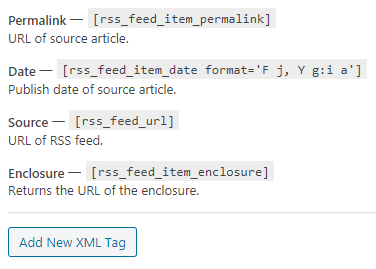
The final four shortcodes cannot be modified and are simply there to allow for some reference information to be added to the imported post after import to credit the original content creators.
- Permalink - Includes the URL address of the original article. You can use this shortcode
[rss_feed_item_permalink]in case you want to print out the URL of the article in the content or elsewhere in the imported post. - Date - Includes the Publish date of the article. You can use this shortcode
[rss_feed_item_date]in case you want to print out the URL of the article in the content or elsewhere in the imported post. The format attribute of the date is taken from the PHP format and can be changed in many ways. Please, check the following guide for more options. - Source - Includes the URL of the RSS feed source that has been imported. For example, if the permalink is https://www.cminds.com/blog/wordpress/10-wordpress-glossary-plugins/ then the source will be the link that was used for fetching the articles - https://www.cminds.com/feed/
- Enclosure - Returns the URL of the enclosure. RSS enclosures are hyperlinks to multimedia content related to that feed - for instance, the .mp3 file of a podcast feed or the .jpg file of an image from a gallery feed.
Custom XML Tag
Finally, the Add New XML Tag button can be used to create new shortcodes. Tags can be given a name and then the shortcode attributes added between the square braces.

This is an important feature that can support processing additional metadata tags which are found in the post RSS feed. For example, if the feed includes a price tag, you can add the tag description in the section and then use it elsewhere in the post template.
Step 1 - Identifying the Tag
We need to find the tag where the desired content is located. Let's consider the following example:
You would like to extract the contents Itunes Duration <itunes:duration> and Date of Publication <pubDate>.
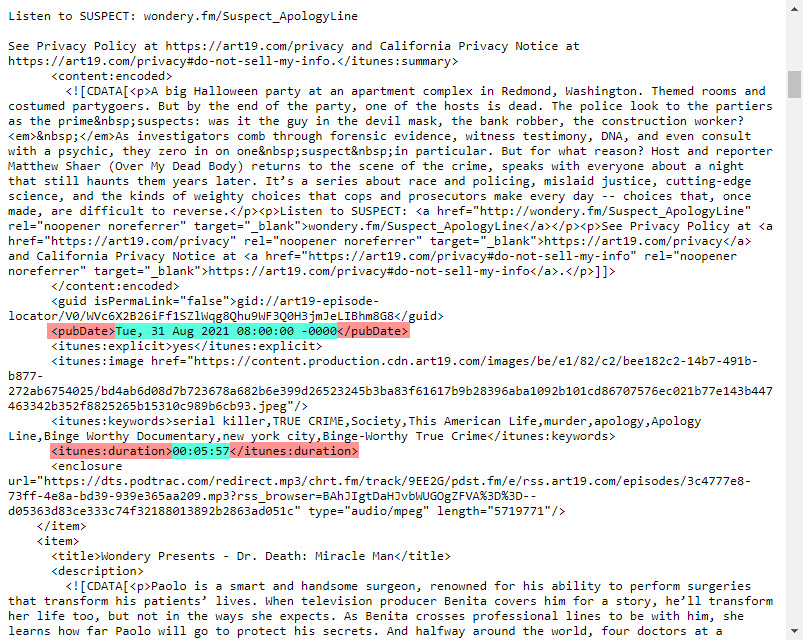
Restriction
It's not possible to:
- Get tags inside another tag.
- Get tag content if it is a complex of tags (has tags inside).
Note that <itunes:duration> has a prefix before the ":" ("itunes") and <pubDate> doesn't have any prefix. This takes us to the next step.
Step 2 - Choosing The Namespace
Now it's time to add the tags, and for that, we need to know the namespace of each. Namespace refers to the way the elements are written down and organized.
The end result should be something like this:

There are simple rules, depending on the existence of a prefix:
- Tag has prefix
- Namespace will be the prefix. Example: <itunes:duration> → itunes is the prefix, so it's the Namespace.
- Tag Name will be the remaining of the word. Example: <itunes:duration> → "duration" is the Tag Name.
- Tag doesn't have prefix
- Namespace will be RSS 2.0 - Blank. Example: <pubDate> → RSS 2.0 is the Namespace.
- Tag Name will be the whole word. Example: <pubDate> → Tag Name is the whole tag, "pubDate".
By adding the guide tag to the Add New XML Tag option, you need to write a shortcode for each. In this case, let's call them [rss_feed_pubdate] and [rss_feed_duration] . We will use these shortcodes while building a template for a final post. This takes us to the next step.
List of Namespaces
- RSS 2.0 - Blank. RSS 2.0 doesn't have a namespace. If there the tag has no prefix, choose this.
- XML Learn more
- ATOM 1.0 Learn more
- ATOM 0.3 Learn more
- RDF Learn more
- RSS 0.90 Learn more
- RSS 1.0 Learn more
- RSS 1.0 MODULES CONTENT Learn more
- DC 1.0 Learn more
- DC 1.1 Learn more
- W3C BASIC GEO Learn more
- GEORSS Learn more
- MEDIARSS Learn more
- ITUNES Learn more
- XHTML Learn more
- BASE GOOGLE 1.0 Learn more
Building Post Template
Now it's time to define, how the posts with fetched articles should look like on your site. To define parameters for a post template go to the section Post Template (Export).
Once the RSS is imported the RSS Importer Plugin works to Export the post onto your own site. The following settings determine how this output will appear and what attributes it will have.

- Post Type - Choose what kind of post it will be. A page, a custom post type or something else. The default is a WordPress post.
- Category - The category that imported posts will fall under can be configured here. This applied only if the post type created on your site is a regular "Post".
- Alternatively, the checkbox below can be checked to Use category from feed item. Doing this will use the original category. If this does not exist on your site, it will create it.
- Categories cannot be created manually here in the Post Template section. To add new categories this must be done before in Posts → Categories.
- Alternatively, the checkbox below can be checked to Use category from feed item. Doing this will use the original category. If this does not exist on your site, it will create it.
- Status - Determines the publish status of the Post. It can be published automatically, saved as a draft or held for revision. It can also be set as private.
- Author - Choose between:
- Get author from item - Try to fetch the authors of the RSS item and set them as the author.
Select author by default - Setting a Site user as the Author.
Note: How the Author Fetching Works
If the option Get author from item is checked, the fetched author from RSS source (XML file) is compared with the list of existing users on your site. If fetched author's username or email matches the username or email of one of your site users, then that user will be set as the post author. If there is no matching users on your site or if the option Get author from item is not checked, then the default user that is chosen in the dropdown Select author by default will be set as the post author.
Important: the plugin does not create new users on your site based on fetched post authors from RSS source (XML file).
- Published on - Choose between the original publication date and the Import date as the date to be used for the publication date to appear on your site.
- Add "nofollow" to links - Adds the nofollow attribute to links in the post. This is important for search engines that are indexing your site in case you don't want them to follow the links included in the important articles.
- Set featured image - Downloads and saves the featured image to the WordPress media of your site. Once found, it will also be set as the featured image for the saved post. You can also use the featured image as a shortcode using the following
[rss_feed_item_image]- Number of image in feed content - Which image should be used as the featured image. "1" means first image, "2" the second and so on. This option affects all items of current feed.
- Exclusive use of default image - When this option is selected default image will be set as featured image despite the presence of any image in the fetched article.
- Disable security filters - Some content requires disabling of security filters
Fill Yoast SEO Metadata
What is Yoast SEO?
Yoast SEO is a search engine optimization plugin for WordPress. This plugin has lots of features, like Automated technical SEO improvements, Advanced XML sitemaps, Title and meta description templating and many more.
If you are using the Yoast SEO plugin, you can fill the meta description and canonical data. This applies to both free and premium versions of Yoast.
There you can find two options. Text areas for editing appear when you check needed option:

- Fill Yoast SEO meta description - Write here meta description.
- Fill Yoast SEO meta canonical - It usually contains post permalink, but now you can change it.
Altering the Template
The Template can be altered using the shortcodes shown in the panel or with some manually entered text. You can also apply the relevant parameters to each of the shortcodes.
In our example we will fetch posts from podcast RSS feed, so let's use standard customizable shortcodes (1) to import title, content and to set the source of fetching, and also use our new XML tags (2) to import podcast duration and date of publication. We can also add some HTML to make the template more informative.
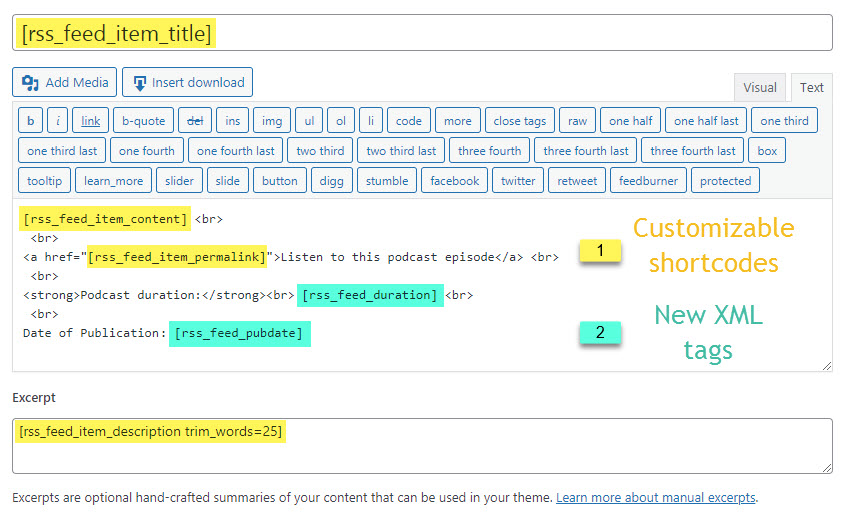
Excerpt
At the end of the panel, you will also find the Excerpt field. The excerpt is a hand-crafted summary of the content (learn more).
By default, it contains a shortcode to set a Word Limit. You can alter the number in the shortcode to define how many words will be captured as the excerpt. So, for instance, the following shortcode will import 25 words from each post as their excerpts:
[rss_feed_item_description trim_words=25]
Take a note that every post will follow this rule.
Don't Forget To Save!
After completing the configuration for the Feed remember to Save. Either as a Draft by clicking Save Draft or as a Published Feed by clicking Publish/Update on the upper right of the page.
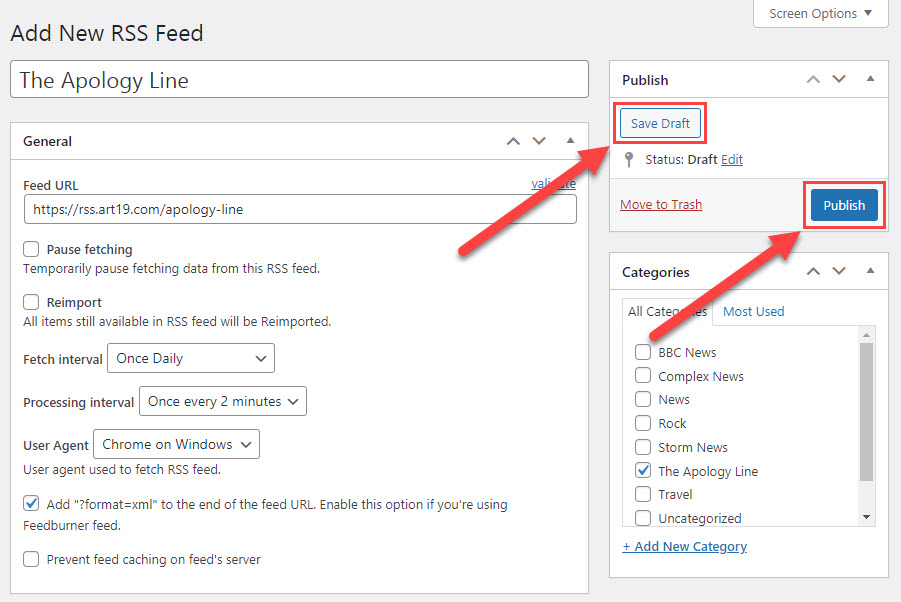
Result
Let's see the result - how the posts are imported with our template:

End Result
Following instructions found in the plugin and guides, you should be able to build a post template for fetched articles.
Use Case Front-End

Extra - No Image Is Shown - Troubleshooting
Images can only be imported if the RSS feed includes images in its items and if they are not protected.
Even if a site has images, its feed may not include them. If that's the case, the plugin cannot fetch images.
Step 1 - Finding Out If RSS Feed Provides Images
Images can be present in feeds as image tags, enclosure.
The quick way to check this is to open the feed on your browser and search for common image extensions, such as .jpg and .png.
Examples
HTML Tag

Enclosure

Thumbnail item

Step 2 - Follow Plugins' Settings
If the feed provides images and they are not fetched during import, the issue might be in the settings. Follow the steps at:
- CM RSS Post Importer - Images Import
- CM Curated RSS Aggregator (CMCRA) - Options - Plugin Appearance
 |
More information about the RSS Post Importer plugin for WordPress Other WordPress products can be found at CreativeMinds WordPress Store |
 |
Let us know how we can Improve this Product Documentation Page To open a Support Ticket visit our support center |
